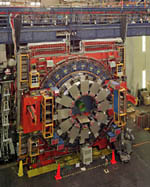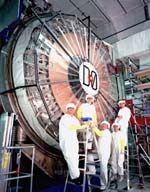Inquiring Minds
|
Physics at Fermilab main page | accelerators | collider experiments | neutrino physics | technology computing | theory | astrophysics | discoveries at Fermilab |
||||
|
||||
|
Beams of protons and antiprotons collide at nearly the speed of light in Fermilab's Tevatron accelerator. Millions of times a second, protons and antiprotons burst into showers of secondary particles: quarks, electrons, muons, neutrinos, ... there are more than a hundred possibilities. By studying the particles, physicists learn about the elementary building blocks and fundamental forces that determine the nature of matter—and the ultimate structure and evolution of the universe.
At Fermilab, two huge detectors called CDF and DZero, both consisting of many different detection subsystems, are located in the Tevatron beamline. The particle collisions take place at the centers of these collider detectors. The detectors observe the collisions, recognize the particles that come flying out and record all information for later analysis..
|
| last modified 2/22/2002 email Fermilab |
FRLsDFx9eyfrPXgV




